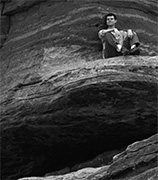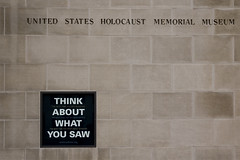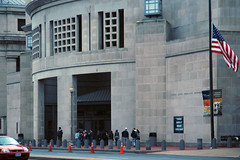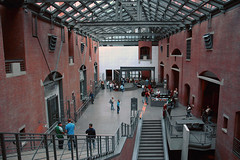Nietzsche's monster allegory
It's just a core question about the state of our souls that most theologians have to ask by trade. Who doesn't at some time in their life feel vanquished, as in empty.
Most have the experience of rejection. When our offerings have been rejected enough times and we've been "put in place" (which in this case means reminded that they have no say in the matter at hand) enough times, we can actually convince ourselves that we're worthless... at least for a time... for most of us. Some never come back.
I wonder about that emptiness. That dead state. It's a type of insanity that breeds an awareness. We are not as important as we may hope to be. Our accomplishments don't mean anything to the big picture. Our impact is infinitesimally small. No matter how intelligent you are on a matter, someone else has a more desirable opinion to listen to... because they're not you. Life is personal, so we take these rejections personally whether we should or should not.
With a fair amount of consideration (or distraction) of the matter, most people return back a little more somber ... a little less bright eyed ... a lot less enthused. That was the part about "Flowers for Algernon" that freaked me out the most. People can be so subjugated and diminished to the point that their purpose and meaning in life is stripped away with it. It's akin to breaking a wild stallion then tethering it to a basement grain mill for the rest of its life.
When I feel cramped up too much, or see others in that state I find it helpful to put energy into something creative - in a displayable way. It reminds me that no matter how far down people may push me or how much they crowd me out that I am unique and add to life in a way that they do not.
I admit that there are times at work and even at play that I have to "play dead", myself. Sometimes a business' survival is more important at a given time and my participation to help that business, though it may be doldrum or even maddening at times, helps out others - it expands my world and restates my belief that life is more than just myself.
Possums and birds play dead to survive. Like I mentioned before, sometimes we have to do that, too. But if people "play dead" for too long I've seen and experienced that the spirit is quenched and a more sinister death starts to settle in. We began to feel robotic and sense that we are only a cog in a cold machine. Adults aren't the only ones prone to this.
It starts when we are little. We go to a failing school system; we watch commercials that train us to believe we are unfit (without their product); any friends or family that buy into the culture second guess everything we do to the point that we second guess ourselves; we go to a university where professors almost strategically tell us that whatever we know/think/love is crap (unless you agree with their world view - or at least bribe them a little); in the corporate world you're told that your job is not to think (at least for most).
Each time these attacks wave and crest in consuming foamy hands to wrench our necks when we try to be creative. It's policy; it's bureaucracy; it's parenting and policing and mentoring gone wrong.
I look back at a week ago when one of my children were so excited about something they were doing. I shooed them off "Daddy has to work. Don't bother me right now." and they slump away a little. I became the very monster that bored its way into my life until I dolefully gave in. That sucks!
Nietzsche was incorrect about fighting monsters. It's when you're spirit is defeated by the monster that you become like it.
Most have the experience of rejection. When our offerings have been rejected enough times and we've been "put in place" (which in this case means reminded that they have no say in the matter at hand) enough times, we can actually convince ourselves that we're worthless... at least for a time... for most of us. Some never come back.
I wonder about that emptiness. That dead state. It's a type of insanity that breeds an awareness. We are not as important as we may hope to be. Our accomplishments don't mean anything to the big picture. Our impact is infinitesimally small. No matter how intelligent you are on a matter, someone else has a more desirable opinion to listen to... because they're not you. Life is personal, so we take these rejections personally whether we should or should not.
With a fair amount of consideration (or distraction) of the matter, most people return back a little more somber ... a little less bright eyed ... a lot less enthused. That was the part about "Flowers for Algernon" that freaked me out the most. People can be so subjugated and diminished to the point that their purpose and meaning in life is stripped away with it. It's akin to breaking a wild stallion then tethering it to a basement grain mill for the rest of its life.
When I feel cramped up too much, or see others in that state I find it helpful to put energy into something creative - in a displayable way. It reminds me that no matter how far down people may push me or how much they crowd me out that I am unique and add to life in a way that they do not.
I admit that there are times at work and even at play that I have to "play dead", myself. Sometimes a business' survival is more important at a given time and my participation to help that business, though it may be doldrum or even maddening at times, helps out others - it expands my world and restates my belief that life is more than just myself.
Possums and birds play dead to survive. Like I mentioned before, sometimes we have to do that, too. But if people "play dead" for too long I've seen and experienced that the spirit is quenched and a more sinister death starts to settle in. We began to feel robotic and sense that we are only a cog in a cold machine. Adults aren't the only ones prone to this.
It starts when we are little. We go to a failing school system; we watch commercials that train us to believe we are unfit (without their product); any friends or family that buy into the culture second guess everything we do to the point that we second guess ourselves; we go to a university where professors almost strategically tell us that whatever we know/think/love is crap (unless you agree with their world view - or at least bribe them a little); in the corporate world you're told that your job is not to think (at least for most).
Each time these attacks wave and crest in consuming foamy hands to wrench our necks when we try to be creative. It's policy; it's bureaucracy; it's parenting and policing and mentoring gone wrong.
I look back at a week ago when one of my children were so excited about something they were doing. I shooed them off "Daddy has to work. Don't bother me right now." and they slump away a little. I became the very monster that bored its way into my life until I dolefully gave in. That sucks!
Nietzsche was incorrect about fighting monsters. It's when you're spirit is defeated by the monster that you become like it.
Labels: death, identity, life, love, Monsters, Nietzsche, Purpose of Life, self management, The Human Soul, think











